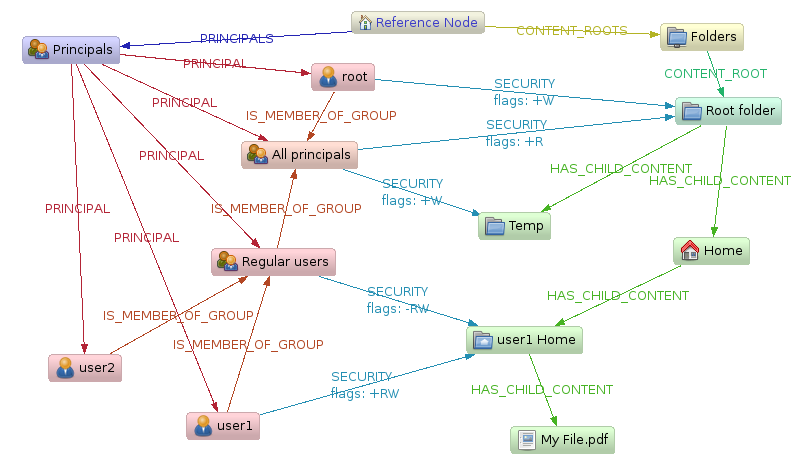This example gives a generic overview of an approach to handling Access Control Lists (ACLs) in graphs, and a simplified example with concrete queries.
Generic approach
In many scenarios, an application needs to handle security on some form of managed objects. This example describes one pattern to handle this through the use of a graph structure and traversers that build a full permissions-structure for any managed object with exclude and include overriding possibilities. This results in a dynamic construction of ACLs based on the position and context of the managed object.
The result is a complex security scheme that can easily be implemented in a graph structure, supporting permissions overriding, principal and content composition, without duplicating data anywhere.
Technique
As seen in the example graph layout, there are some key concepts in this domain model:
-
The managed content (folders and files) that are connected by
HAS_CHILD_CONTENTrelationships -
The Principal subtree pointing out principals that can act as ACL members, pointed out by the
PRINCIPALrelationships. -
The aggregation of principals into groups, connected by the
IS_MEMBER_OFrelationship. One principal (user or group) can be part of many groups at the same time. -
The
SECURITY— relationships, connecting the content composite structure to the principal composite structure, containing a addition/removal modifier property ("+RW").
Constructing the ACL
The calculation of the effective permissions (e.g. Read, Write, Execute) for a principal for any given ACL-managed node (content) follows a number of rules that will be encoded into the permissions-traversal:
Top-down-Traversal
This approach will let you define a generic permission pattern on the root content, and then refine that for specific sub-content nodes and specific principals.
- Start at the content node in question traverse upwards to the content root node to determine the path to it.
-
Start with a effective optimistic permissions list of "all permitted" (
111in a bit encoded ReadWriteExecute case) or000if you like pessimistic security handling (everything is forbidden unless explicitly allowed). -
Beginning from the topmost content node, look for any
SECURITYrelationships on it. -
If found, look if the principal in question is part of the end-principal of the
SECURITYrelationship. -
If yes, add the "
+" permission modifiers to the existing permission pattern, revoke the "-" permission modifiers from the pattern. - If two principal nodes link to the same content node, first apply the more generic prinipals modifiers.
- Repeat the security modifier search all the way down to the target content node, thus overriding more generic permissions with the set on nodes closer to the target node.
The same algorithm is applicable for the bottom-up approach, basically just traversing from the target content node upwards and applying the security modifiers dynamically as the traverser goes up.
Example
Now, to get the resulting access rights for e.g. "user 1" on the "My File.pdf" in a Top-Down
approach on the model in the graph above would go like:
-
Traveling upward, we start with "
Root folder", and set the permissions to11initially (only considering Read, Write). -
There are two
SECURITYrelationships to that folder. User 1 is contained in both of them, but "root" is more generic, so apply it first then "All principals"+W+R→11. -
"
Home" has noSECURITYinstructions, continue. -
"
user1 Home" hasSECURITY. First apply "Regular Users" (-R-W) →00, Then "user 1" (+R+W) →11. -
The target node "
My File.pdf" has noSECURITYmodifiers on it, so the effective permissions for "User 1" on "My File.pdf" areReadWrite→11.
Read-permission example
In this example, we are going to examine a tree structure of directories and
files. Also, there are users that own files and roles that can be assigned to
users. Roles can have permissions on directory or files structures (here we model
only canRead, as opposed to full rwx Unix permissions) and be nested. A more thorough
example of modeling ACL structures can be found at
How to Build Role-Based Access Control in SQL.
Find all files in the directory structure
In order to find all files contained in this structure, we need a variable length
query that follows all contains relationships and retrieves the nodes at the other
end of the leaf relationships.
MATCH ({ name: 'FileRoot' })-[:contains*0..]->(parentDir)-[:leaf]->(file)
RETURN file
resulting in:
| file |
|---|
| 2 rows |
|
|
What files are owned by whom?
If we introduce the concept of ownership on files, we then can ask for the owners of the files we find — connected via owns relationships to file nodes.
MATCH ({ name: 'FileRoot' })-[:contains*0..]->()-[:leaf]->(file)<-[:owns]-(user)
RETURN file, user
Returning the owners of all files below the FileRoot node.
| file | user |
|---|---|
| 2 rows | |
|
|
|
|
Who has access to a File?
If we now want to check what users have read access to all Files, and define our ACL as
- The root directory has no access granted.
-
Any user having a role that has been granted
canReadaccess to one of the parent folders of a File has read access.
In order to find users that can read any part of the parent folder hierarchy above the files, Cypher provides optional variable length path.
MATCH (file)<-[:leaf]-()<-[:contains*0..]-(dir) OPTIONAL MATCH (dir)<-[:canRead]-(role)-[:member]->(readUser) WHERE file.name =~ 'File.*' RETURN file.name, dir.name, role.name, readUser.name
This will return the file, and the directory where the user has the canRead permission along
with the user and their role.
| file.name | dir.name | role.name | readUser.name |
|---|---|---|---|
| 9 rows | |||
|
|
|
|
|
|
|
|
|
|
|
|
|
|
|
|
|
|
|
|
|
|
|
|
|
|
|
|
|
|
|
|
|
|
|
|
The results listed above contain null for optional path segments, which can be mitigated by either asking several
queries or returning just the really needed values.

